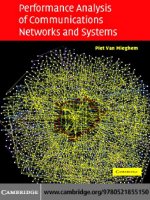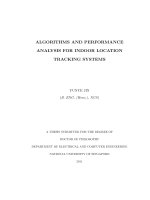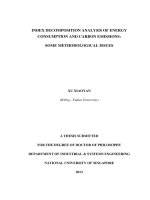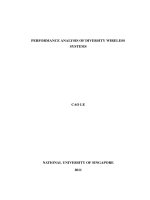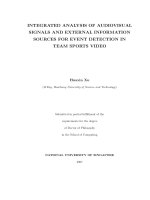performance analysis of communications networks and systems
Bạn đang xem bản rút gọn của tài liệu. Xem và tải ngay bản đầy đủ của tài liệu tại đây (10.69 MB, 543 trang )
PERFORMANCE ANALYSIS
OF COMMUNICATIONS
NETWORKS AND SYSTEMS
PIET VAN MIEGHEM
Delft University of Technology
cambridge university press
Cambridge, New York, Melbourne, Madrid, Cape Town, Singapore, São Paulo
Cambridge University Press
The Edinburgh Building, Cambridge cb2 2ru,UK
First published in print format
isbn-13 978-0-521-85515-0
isbn-13 978-0-511-16917-5
© Cambridge University Press 2006
2006
Informationonthistitle:www.cambrid
g
e.or
g
/9780521855150
This publication is in copyright. Subject to statutory exception and to the provision of
relevant collective licensing agreements, no reproduction of any part may take place
without the written permission of Cambridge University Press.
isbn-10 0-511-16917-5
isbn-10 0-521-85515-2
Cambridge University Press has no responsibility for the persistence or accuracy of urls
for external or third-party internet websites referred to in this publication, and does not
guarantee that any content on such websites is, or will remain, accurate or appropriate.
Published in the United States of America by Cambridge University Press, New York
www.cambridge.org
hardback
eBook (NetLibrary)
eBook (NetLibrary)
hardback
Waar een wil is, is een weg.
to my father
to my wife Saskia
and my sons Vincent, Nathan and Laurens
Contents
Preface xi
1 Introduction 1
Part I Probability theory 7
2 Random variables 9
2.1 Probability theory and set theory 9
2.2 Discrete random variables 16
2.3 Continuous random variables 20
2.4 The conditional probability 26
2.5 Several random variables and independence 28
2.6 Conditional expectation 34
3 Basic distributions 37
3.1 Discrete random variables 37
3.2 Continuous random variables 43
3.3 Derived distributions 47
3.4 Functions of random variables 51
3.5 Examples of other distributions 54
3.6 Summary tables of probability distributions 58
3.7 Problems 59
4 Correlation 61
4.1 Generation of correlated Gaussian random variables 61
4.2 Generation of correlated random variables 67
4.3 The non-linear transformation method 68
v
vi Contents
4.4 Examples of the non-linear transformation method 74
4.5 Linear combination of independent auxiliary random
variables 78
4.6 Problem 82
5 Inequalities 83
5.1 The minimum (maximum) and infimum (supremum) 83
5.2 Continuous convex functions 84
5.3 Inequalities deduced from the Mean Value Theorem 86
5.4 The Markov and Chebyshev inequalities 87
5.5 The Hölder, Minkowski and Young inequalities 90
5.6 The Gauss inequality 92
5.7 The dominant pole approximation and large deviations 94
6 Limit laws 97
6.1 General theorems from analysis 97
6.2 Law of Large Numbers 101
6.3 Central Limit Theorem 103
6.4 Extremal distributions 104
Part II Stochastic processes 113
7 The Poisson process 115
7.1 A stochastic process 115
7.2 The Poisson process 120
7.3 Properties of the Poisson process 122
7.4 The nonhomogeneous Poisson process 129
7.5 The failure rate function 130
7.6 Problems 132
8 Renewal theory 137
8.1 Basic notions 138
8.2 Limit theorems 144
8.3 The residual waiting time 149
8.4 The renewal reward process 153
8.5 Problems 155
9 Discrete-time Markov chains 157
9.1 Definition 157
Contents vii
9.2 Discrete-time Markov chain 158
9.3 The steady-state of a Markov chain 168
9.4 Problems 177
10 Continuous-time Markov chains 179
10.1 Definition 179
10.2 Properties of continuous-time Markov processes 180
10.3 Steady-state 187
10.4 The embedded Markov chain 188
10.5 The transitions in a continuous-time Markov chain 193
10.6 Example: the two-state Markov chain in continuous-time 195
10.7 Time reversibility 196
10.8 Problems 199
11 Applications of Markov chains 201
11.1 Discrete Markov chains and independent random vari-
ables 201
11.2 The general random walk 202
11.3 Birth and death process 208
11.4 A random walk on a graph 218
11.5 Slotted Aloha 219
11.6 Ranking of webpages 224
11.7 Problems 228
12 Branching processes 229
12.1 The probability generating function 231
12.2 The limit Z of the scaled random variables Z
n
233
12.3 The Probability of Extinction of a Branching Process 237
12.4 Asymptotic behavior of Z 240
12.5 A geometric branching processes 243
13 General queueing theory 247
13.1 A queueing system 247
13.2 The waiting process: Lindley’s approach 252
13.3 The Bene˘s approach to the unfinished work 256
13.4 The counting process 263
13.5 PASTA 266
13.6 Little’s Law 267
14 Queueing models 271
viii Contents
14.1 The M/M/1 queue 271
14.2 Variants of the M/M/1 queue 276
14.3 The M/G/1 queue 283
14.4 The GI/D/m queue 289
14.5 The M/D/1/K queue 296
14.6 The N*D/D/1 queue 300
14.7 The AMS queue 304
14.8 The cell loss ratio 309
14.9 Problems 312
Part III Physics of networks 317
15 General characteristics of graphs 319
15.1 Introduction 319
15.2 The number of paths with m hops 321
15.3 The degree of a node in a graph 322
15.4 Connectivity and robustness 325
15.5 Graph metrics 328
15.6 Random graphs 329
15.7 The hopcount in a large, sparse graph with unit link
weights 340
15.8 Problems 346
16 The Shortest Path Problem 347
16.1 The shortest path and the link weight structure 348
16.2 The shortest path tree in N
Q
with exponential link
weights 349
16.3 The hopcount k
Q
in the URT 354
16.4 The weight of the shortest path 359
16.5 The flooding time W
Q
361
16.6 The degree of a node in the URT 366
16.7 The minimum spanning tree 373
16.8 The proof of the degree Theorem 16.6.1 of the URT 380
16.9 Problems 385
17 The e!ciency of multicast 387
17.1 General results for j
Q
(p) 388
17.2 The random graph J
s
(Q) 392
17.3 The n-ary tree 401
Contents ix
17.4 The Chuang—Sirbu law 404
17.5 Stability of a multicast shortest path tree 407
17.6 Proof of (17.16): j
Q
(p) for random graphs 410
17.7 Proof of Theorem 17.3.1: j
Q
(p) for n-ary trees 414
17.8 Problem 416
18 The hopcount to an anycast group 417
18.1 Introduction 417
18.2 General analysis 419
18.3 The n-ary tree 423
18.4 The uniform recursive tree (URT) 424
18.5 Approximate analysis 431
18.6 The performance measure in exponentially growing
trees 432
Appendix A Stochastic matrices 435
Appendix B Algebraic graph theory 471
Appendix C Solutions of problems 493
Bibliography 523
Index 529
Preface
Performance analysis belongs to the domain of applied mathematics. The
majordomainofapplicationinthisbookconcernstelecommunicationssys-
tems and networks. We will mainly use stochastic analysis and probability
theory to address problems in the performance evaluation of telecommuni-
cations systems and networks. The first chapter will provide a motivation
and a statement of several problems.
This book aims to present methods rigorously, hence mathematically, with
minimal resorting to intuition. It is my belief that intuition is often gained
after the result is known and rarely before the problem is solved, unless the
problem is simple. Techniques and terminologies of axiomatic probability
(such as definitions of probability spaces, filtration, measures, etc.) have
been omitted and a more direct, less abstract approach has been adopted.
In addition, most of the important formulas are interpreted in the sense of
“What does this mathematical expression teach me?” This last step justifies
the word “applied”, since most mathematical treatises do not interpret as
it contains the risk to be imprecise and incomplete.
The field of stochastic processes is much too large to be covered in a single
book and only a selected number of topics has been chosen. Most of the top-
ics are considered as classical. Perhaps the largest omission is a treatment
of Brownian processes and the many related applications. A weak excuse
for this omission (besides the considerable mathematical complexity) is that
Brownian theory applies more to physics (analogue fields) than to system
theory (discrete components). The list of omissions is rather long and only
the most noteworthy are summarized: recent concepts such as martingales
and the coupling theory of stochastic variables, queueing networks, schedul-
ing rules, and the theory of long-range dependent random variables that cur-
rently governs in the Internet. The confinement to stochastic analysis also
excludes the recent new framework, called Network Calculus by Le Boudec
and Thiran (2001). Network calculus is based on min-plus algebra and has
been applied to (Inter)network problems in a deterministic setting.
As prerequisites, familiarity with elementary probability and the knowl-
edge of the theory of functions of a complex variable are assumed. Parts in
the text in
small font refer to more advanced topics or to computations that
can be skipped at first reading. Part I (Chapters 2—6) reviews probability
theory and it is included to make the remainder self-contained. The book
essentially starts with Chapter 7 (Part II) on Poisson processes. The Pois-
xi
xii Preface
son process (independent increments and discontinuous sample paths) and
Brownian motion (independent increments but continuous sample paths)
are considered to be the most important basic stochastic processes. We
briefly touch upon renewal theory to move to Markov processes. The theory
of Markov processes is regarded as a fundament for many applications in
telecommunications systems, in particular queueing theory. A large part
of the book is consumed by Markov processes and its applications. The
last chapters of Part II dive into queueing theory. Inspired by intriguing
problems in telephony at the beginning of the twentieth century, Erlang
has pushed queueing theory to the scene of sciences. Since his investiga-
tions, queueing theory has grown considerably. Especially during the last
decade with the advent of the Asynchronous Transfer Mode (ATM) and the
worldwide Internet, many early ideas have been refined (e.g. discrete-time
queueing theory, large deviation theory, scheduling control of prioritized
flows of packets) and new concepts (self-similar or fractal processes) have
been proposed. Part III covers current research on the physics of networks.
This Part III is undoubtedly the least mature and complete. In contrast to
most books, I have chosen to include the solutions to the problems in an
Appendix to support self-study.
I am grateful to colleagues and students whose input has greatly improved
this text. Fernando Kuipers and Stijn van Langen have corrected a large
number of misprints. Together with Fernando, Milena Janic and Almer-
ima Jamakovic have supplied me with exercises. Gerard Hooghiemstra has
made valuable comments and was always available for discussions about
my viewpoints. Bart Steyaert eagerly gave the finer details of the generat-
ing function approach to the GI/D/m queue. Jan Van Mieghem has given
overall comments and suggestions beside his input with the computation of
correlations. Finally, I thank David Hemsley for his scrupulous corrections
in the original manuscript.
Although this book is intended to be of practical use, in the course of
writing it, I became more and more persuaded that mathematical rigor has
ample virtues of its own.
Perasperaadastra
January 2006 Piet Van Mieghem
1
Introduction
The aim of this first chapter is to motivate why stochastic processes and
probability theory are useful to solve problems in the domain of telecommu-
nications systems and networks.
In any system, or for any transmission of information, there is always a
non-zero probability of failure or of error penetration. A lot of problems in
quantifying the failure rate, bit error rate or the computation of redundancy
to recover from hazards are successfully treated by probability theory. Often
we deal in communications with a large variety of signals, calls, source-
destination pairs, messages, the number of customers per region, and so on.
And, most often, precise information at any time is not available or, if it
is available, deterministic studies or simulations are simply not feasible due
to the large number of dierent parameters involved. For such problems, a
stochastic approach is often a powerful vehicle, as has been demonstrated
in the field of physics.
Perhaps the first impressing result of a stochastic approach was Boltz-
mann’s and Maxwell’s statistical theory. They studied the behavior of parti-
cles in an ideal gas and described how macroscopic quantities as pressure and
temperature can be related to the microscopic motion of the huge amount
of individual particles. Boltzmann also introduced the stochastic notion of
the thermodynamic concept of entropy V,
V = n log Z
where Z denotes the total number of ways in which the ensembles of parti-
cles can be distributed in thermal equilibrium and where n is a proportion-
ality factor, afterwards attributed to Boltzmann as the Boltzmann constant.
The pioneering work of these early physicists such as Boltzmann, Maxwell
and others was the germ of a large number of breakthroughs in science.
Shortly after their introduction of stochastic theory in classical physics, the
1
2 Introduction
theory of quantum mechanics (see e.g. Cohen-Tannoudji et al., 1977) was
established. This theory proposes that the elementary building blocks of
nature, the atom and electrons, can only be described in a probabilistic
sense. The conceptually di!cult notion of a wave function whose squared
modulus expresses the probability that a set of particles is in a certain state
and the Heisenberg’s uncertainty relation exclude in a dramatic way our
deterministic, macroscopic view on nature at the fine atomic scale.
At about the same time as the theory of quantum mechanics was being
created, Erlang applied probability theory to the field of telecommunica-
tions. Erlang succeeded to determine the number of telephone input lines
p ofaswitchinordertoserveQ
V
customers with a certain probability s.
Perhaps his most used formula is the Erlang E formula (14.17), derived in
Section 14.2.2,
Pr [Q
V
= p]=
p
p!
P
p
m=0
m
m!
where the load or tra!c intensity is the ratio of the arrival rate of calls to
the telephone local exchange or switch over the processing rate of the switch
per line. By equating the desired blocking probability s =Pr[Q
V
= p],say
s =10
34
, the number of input lines p can be computed for each load .
Due to its importance, books with tables relating s, and p were published.
Another pioneer in the field of communications that deserves to be men-
tioned is Shannon. Shannon explored the concept of entropy V.Hein-
troduced (see e.g. Walrand, 1998) the notion of the Shannon capacity of a
channel, the maximum rate at which bits can be transmitted with arbitrary
small (but non zero) probability of errors, and the concept of the entropy
rate of a source which is the minimum average number of bits per sym-
bol required to encode the output of a source. Many others have extended
his basic ideas and so it is fair to say that Shannon founded the field of
information theory.
A recent important driver in telecommunication is the concept of qual-
ity of service (QoS). Customers can use the network to transmit dierent
types of information such as pictures, files, voice, etc. by requiring a spe-
cific level of service depending on the type of transmitted information. For
example, a telephone conversation requires that the voice packets arrive at
the receiver G ms later, while a file transfer is mostly not time critical but
requires an extremely low information loss probability. The value of the
mouth-to-ear delay G is clearly related to the perceived quality of the voice
conversation. As long as G?150 ms, the voice conversation has toll qual-
ity, which is roughly speaking, the quality that we are used to in classical
Introduction 3
telephony. When G exceeds 150 ms, rapid degradation is experienced and
when GA300 ms, most of the test persons have great di!cultyinun-
derstanding the conversation. However, perceived quality may change from
person to person and is di!cult to determine, even for telephony. For ex-
ample, if the test person knows a priori that the conversation is transmitted
over a mobile or wireless channel as in GSM, he or she is willing to tolerate
a lower quality. Therefore, quality of service is both related to the nature
of the information and to the individual desire and perception. In future
Internetworking, it is believed that customers may request a certain QoS
for each type of information. Depending on the level of stringency, the net-
work may either allow or refuse the customer. Since customers will also pay
an amount related to this QoS stringency, the network function that deter-
mines to either accept or refuse a call for service will be of crucial interest
to any network operator. Let us now state the connection admission control
(CAC) problem for a voice conversation to illustrate the relation to stochas-
tic analysis: “How many customers p are allowed in order to guarantee that
the ensemble of all voice packets reaches the destination within G ms with
probability s?”This problem is exceptionally di!cult because it depends on
the voice codecs used, the specifics of the network topology, the capacity of
the individual network elements, the arrival process of calls from the cus-
tomers, the duration of the conversation and other details. Therefore, we
will simplify the question. Let us first assume that the delay is only caused
by the waiting time of a voice packet in the queue of a router (or switch).
As we will see in Chapter 13, this waiting time W of voice packets in a single
queueing system depends on (a) the arrival process: the way voice packets
arrive, and (b) the service process: how they are processed. Let us assume
that the arrival process specified by the average arrival rate and the ser-
vice process specified by the average service rate are known. Clearly, the
arrival rate is connected to the number of customers p.Asimplified
statement of the CAC problem is, “What is the maximum allowed such
that Pr [WAG] ??” In essence, the CAC problem consists in computing
the tail probability of a quantity that depends on parameters of interest. We
have elaborated on the CAC problem because it is a basic design problem
that appears under several disguises. A related dimensioning problem is the
determination of the buer size in a router in order not to lose more than a
certain number of packets with probability s, given the arrival and service
process. The above mentioned problem of Erlang is a third example. An-
other example treated in Chapter 18 is the server placement problem: “How
many replicated servers p are needed to guarantee that any user can access
the information within n hops with probability Pr [k
Q
(p) An] ”, where
4 Introduction
is certain level of stringency and k
Q
(p) is the number of hops towards the
most nearby of the p serversinanetworkwithQ routers.
The popularity of the Internet results in a number of new challenges. The
traditional mathematical models as the Erlang B formula assume “smooth”
tra!c flows (small correlation and Markovian in nature). However, TCP/IP
tra!c has been shown to be “bursty” (long-range dependent, self-similar and
even chaotic, non-Markovian (Veres and Boda, 2000)). As a consequence,
many traditional dimensioning and control problems ask for a new solu-
tion. The self-similar and long range dependent TCP/IP tra!cismainly
caused by new complex interactions between protocols and technologies (e.g.
TCP/IP/ATM/SDH) and by other information transported than voice. It
is observed that the content size of information in the Internet varies con-
siderably in size causing the “Noah eect”: although immense floods are
extremely rare, their occurrence impacts significantly Internet behavior on
a global scale. Unfortunately, the mathematics to cope with the self-similar
and long range dependent processes turns out to be fairly complex and be-
yond the scope of this book.
Finally, we mention the current interest in understanding and modeling
complex networks such as the Internet, biological networks, social networks
and utility infrastructures for water, gas, electricity and transport (cars,
goods, trains). Since these networks consists of a huge number of nodes Q
and links O, classical and algebraic graph theory is often not suited to pro-
duce even approximate results. The beginning of probabilistic graph theory
is commonly attributed to the appearance of papers by Erdös and Rényi in
the late 1940s. They investigated a particularly simple growing model for a
graph: start from Q nodes and connect in each step an arbitrary random,
not yet connected pair of nodes until all O links are used. After about Q@2
steps, as shown in Section 16.7.1, they observed the birth of a giant com-
ponent that, in subsequent steps, swallows the smaller ones at a high rate.
This phenomenon is called a phase transition and often occurs in nature.
In physics it is studied in, for example, percolation theory. To some extent,
the Internet’s graph bears some resemblance to the Erdös-Rényi random
graph. The Internet is best regarded as a dynamic and growing network,
whose graph is continuously changing. Yet, in order to deploy services over
the Internet, an accurate graph model that captures the relevant structural
properties is desirable. As shown in Part III, a probabilistic approach based
on random graphs seems an e!cient way to learn about the Internet’s in-
triguing behavior. Although the Internet’s topology is not a simple Erdös-
Rényi random graph, results such as the hopcount of the shortest path and
thesizeofamulticasttreededucedfromthesimplerandomgraphsprovide
Introduction 5
a first order estimate for the Internet. Moreover, analytic formulas based
on other classes of graphs than the simple random graph prove di!cult to
obtain. This observation is similar to queueing theory, where, beside the
M/G/x class of queues, hardly closed expressions exist.
We hope that this brief overview motivates su!ciently to surmount the
mathematical barriers. Skill with probability theory is deemed necessary
to understand complex phenomena in telecommunications. Once mastered,
the power and beauty of mathematics will be appreciated.
Part I
Probability theory
2
Random variables
This chapter reviews basic concepts from probability theory. A random vari-
able (rv) is a variable that takes certain values by chance. Throughout this
book, this imprecise and intuitive definition su!ces. The precise definition
involves axiomatic probability theory (Billingsley, 1995).
Here, a distinction between discrete and continuous random variables is
made, although a unified approach including also mixed cases via the Stielt-
jes integral (Hardy et al., 1999, pp. 152—157),
R
j({)gi ({),ispossible. In
general, the distribution I
[
({)=Pr[[ {] holdsinbothcases,and
Z
j({)gI
[
({)=
X
n
j(n)Pr[[ = n] where [ is a discrete rv
=
Z
j({)
gI
[
({)
g{
g{ where [ is a continuous rv
In most practical situations, the Stieltjes integral reduces to the Riemann
integral, else, Lesbesgue’s theory of integration and measure theory (Royden,
1988) is required.
2.1 Probability theory and set theory
Pascal (1623—1662) is commonly regarded as one of the founders of proba-
bility theory. In his days, there was much interest in games of chance
1
and
the likelihood of winning a game. In most of these games, there was a finite
number q of possible outcomes and each of them was equally likely. The
1
“La règle des partis”, a chapter in Pascal’s mathematical work (Pascal, 1954), consists of a
series of letters to Fermat that discuss the following problem (together with a more complex
question that is essentially a variant of the probability of gambler’s ruin treated in Section
11.2.1): Consider the game in which 2 dice are thrown q times. How many times q do we have
to throw the 2 dice to throw double six with probability s =
1
2
?
9
10 Random variables
probability of the event D of interest was defined as
Pr [D]=
q
D
q
where q
D
is the number of favorable outcomes (samples points of D). If the
number of outcomes of an experiment is not finite, this classical definition
of probability does not su!ce anymore. In order to establish a coherent and
precise theory, probability theory employs concepts of group or set theory.
The set of all possible outcomes of an experiment is called the sample
space . A possible outcome of an experiment is called a sample point $
that is an element of the sample space . An event D consists of a set of
sample points. An event D is thus a subset of the sample space .The
complement D
f
of an event D consists of all sample points of the sample
space that are not in (the set) D,thusD
f
= \D. Clearly, (D
f
)
f
= D
and the complement of the sample space is the empty set,
f
= > or, vice a
versa, >
f
= .AfamilyF of events is a set of events and thus a subset of the
sample space that possesses particular events as elements. More precisely,
afamilyF of events satisfies the three conditions that define a -field
2
:(a)
>5F,(b)ifD
1
>D
2
>===5 F,then^
"
m=1
D
m
5 F and (c) if D 5 F,thenD
f
5
F. These conditions guarantee that F is closed under countable unions and
intersections of events.
Events and the probability of these events are connected by a probability
measure Pr [=] that assigns to each event of the family F of events of a sample
space a real number in the interval [0> 1].AsAxiom 1, we require that
Pr []=1.IfPr [D]=0, the occurrence of the event D is not possible, while
Pr [D]=1means that the event D is certain to occur. If Pr [D]=s with
0 ?s?1, the event D has probability s to occur.
If the events D and E have no sample points in common, D _ E = >,
the events D and E are called mutually exclusive events.Asanexample,
the event and its complement are mutually exclusive because D _ D
f
= >.
Axiom 2 of a probability measure is that for mutually exclusive events D
and E holds that Pr [D ^E]=Pr[D]+Pr[E]. The definition of a probability
measure and the two axioms are su!cient to build a consistent framework
on which probability theory is founded. Since Pr [>]=0(which follows from
2
AfieldF posseses the properties:
(i) MF;
(ii) if D> E M F,thenD E M F and D KE M F;
(iii) if D M F,thenD
f
M F=
This definition is redundant. For, we have by (ii) and (iii) that (D E)
f
M F.Further,byDe
Morgan’s law (D E)
f
= D
f
K E
f
, which can be deduced from Figure 2.1 and again by (iii),
the argument shows that the reduced statement (ii), if D> E M F,thenD E M F,issu!cient
to also imply that D K E M F.
2.1 Probability theory and set theory 11
Axiom 2 because D _>= > and D = D ^>), for mutually exclusive events
D and E holds that Pr [D _ E]=0.
As a classical example that explains the formal definitions, let us con-
sider the experiment of throwing a fair die. The sample space consists of
all possible outcomes: = {1> 2> 3> 4> 5> 6}. A particular outcome of the
experiment, say $ =3, is a sample point $ 5 . One may be interested in
the event D where the outcome is even in which case D = {2> 4> 6} and
D
f
= {1> 3> 5}.
If D and E are events, the union of these events D ^ E can be written
using set theory as
D ^ E =(D _E) ^(D
f
_E) ^ (D _E
f
)
because D_E, D
f
_E and D_E
f
are mutually exclusive events. The relation
is immediately understood by drawing a Venn diagram as in Fig. 2.1. Taking
A
B
:
ABA
c
BAB
c
Fig. 2.1. A Venn diagram illustrating the union D ^E.
the probability measure of the union yields
Pr [D ^E]=Pr[(D _ E) ^ (D
f
_ E) ^ (D _ E
f
)]
=Pr[D _E]+Pr[D
f
_E]+Pr[D _ E
f
] (2.1)
where the last relation follows from Axiom 2. Figure 2.1 shows that D =
(D _ E) ^ (D _E
f
) and E =(D _ E) ^ (D
f
_ E). Since the events are
mutually exclusive, Axiom 2 states that
Pr [D]=Pr[D _E]+Pr[D _ E
f
]
Pr [E]=Pr[D _E]+Pr[D
f
_ E]
Substitution into (2.1) yields the important relation
Pr [D ^E]=Pr[D]+Pr[E] Pr [D _E] (2.2)
Although derived for the measure Pr [=], relation (2.2) also holds for other
measures, for example, the cardinality (the number of elements) of a set.
12 Random variables
2.1.1 The inclusion-exclusion formula
A generalization of the relation (2.2) is the inclusion-exclusion formula,
Pr [^
q
n=1
D
n
]=
q
X
n
1
=1
Pr [D
n
1
]
q
X
n
1
=1
q
X
n
2
=n
1
+1
Pr [D
n
1
_D
n
2
]
+
q
X
n
1
=1
q
X
n
2
=n
1
+1
q
X
n
3
=n
2
+1
Pr [D
n
1
_ D
n
2
_ D
n
3
]
+ ···+(1)
q1
q
X
n
1
=1
q
X
n
2
=n
1
+1
···
q
X
n
q
=n
q1
+1
Pr
£
_
q
m=1
D
n
m
¤
(2.3)
The formula shows that the probability of the union consists of the sum of
probabilities of the individual events (first term). Since sample points can
belong to more than one event D
n
, the first term possesses double countings.
The second term removes all probabilities of samples points that belong to
precisely two event sets. However, by doing so (draw a Venn diagram), we
also subtract the probabilities of samples points that belong to three events
sets more than needed. The third term adds these again, and so on. The
inclusion-exclusion formula can be written more compactly as,
Pr [^
q
n=1
D
n
]=
q
X
m=1
(1)
m31
q
X
n
1
=1
q
X
n
2
=n
1
+1
···
q
X
n
m
=n
m31
+1
Pr
h
_
m
p=1
D
n
p
i
(2.4)
or with
V
m
=
X
1$n
1
?n
2
?===?n
m
$q
Pr
h
_
m
p=1
D
n
p
i
as
Pr [^
q
n=1
D
n
]=
q
X
m=1
(1)
m31
V
m
(2.5)
Proof of the inclusion-exclusion formula
3
:LetD =
q31
n=1
D
n
and E = D
q
such that
3
Another proof (Grimmett and Stirzacker, 2001, p. 56) uses the indicator function defined in
Section 2.2.1. Useful indicator function relations are
1
DKE
=1
D
1
E
1
D
f
=131
D
1
DXE
=131
(DE)
f =13 1
D
f
KE
f
=131
D
f
1
E
f
=13(1 31
D
)(1 3 1
E
)=1
D
+1
E
+1
D
1
E
=1
D
+1
E
+1
DKE
Generalizing the last relation yields
1
q
n=1
D
n
=13
q
\
n=1
(1 3 1
D
n
)
Multiplying out and taking the expectations using (2.13) leads to (2.3).

